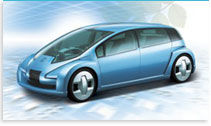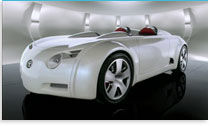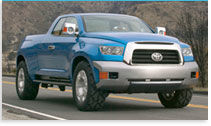- Home >
- About Hybrids
About Hybrids
Environmentally friendly. Fuel efficient to the last drop. And designed with power and performance in mind. Toyota’s latest generation hybrid vehicles offer the most desirable features of both a gasoline engine and an electric motor system. They don’t just raise the bar, they carry it to heights that few thought possible. The ever-expanding Toyota hybrid fleet: allowing us all to breathe more easily.
How Hybrids Work
Toyota’s Hybrid Synergy Drive is a full hybrid because it can operate in three distinct modes. Gas only, electric motor only, or a combination of the two. It doesn’t have to ever be plugged in!
Benefits of Hybrid Technology
Fewer emissions and pollutants. More kilometres on less fuel. Power and performance second to none, and a ride with the quiet smoothness of a luxury vehicle.
The Future of Hybrids
Hybrids are here to stay with the technology being integrated into more and more of the Toyota lineup. At present, that includes the Prius, Prius c, Prius v, Camry Hybrid, and Highlander Hybrid.

-
Important Note
Unless otherwise stated in an individual myth or claim, all comparisons are between a Toyota Hybrid Synergy Drive vehicle and a comparable conventional gasoline engine vehicle (comparable in size, class, equipment) when identically driven under identical conditions.
-
Pricing
Hybrids are expensive
New pricing for all 2017 Toyota hybrids is lower than ever before. The new Prius c will change the pricing landscape for hybrids. Prius c currently has an MSRP price of $23,705*.
-
Important Note
Unless otherwise stated in an individual myth or claim, all comparisons are between a Toyota Hybrid Synergy Drive vehicle and a comparable conventional gasoline engine vehicle (comparable in size, class, equipment) when identically driven under identical conditions.
-
Durability
Hybrid batteries need to be replaced
Hybrid batteries are designed to last the life of the vehicle. Backed by an 8 year, 160,000 km warranty, hybrid taxies have gone well over half a million kilometres on the original battery. The fact of the matter is 99% of the hybrid vehicles we have sold since 2006 have never had their original battery replaced.
Hybrid performance doesn't last long
Taxi fleets in Vancouver and Winnipeg have been using hybrids for over a decade logging millions of kilometres, some with over 1,000,000 km on the odometer.
Nickel Metal Hydride (NiMH) batteries are inferior to Lithium-Ion (Li-Ion batteries)
NiMH works well for hybrid applications that don't see deep charging cycles without the added cost of Li-Ion. NiMH chemistry is appropriate for a hybrid application.
Operation Hybrids have to be plugged in
Hybrids never have to be plugged in. EVs have to be plugged in, PHVs can be plugged in, hybrids never need to be plugged in.
Hybrids are only for city driving
While hybrids benefit from engine-shut-off and more EV driving in the city, Toyota's hybrid engines are of an Atkinson cycle design, which is more efficient even on the highway than comparable conventional gas engine vehicles. Atkinson cycle design (vs Otto cycle in conventional engines) is more efficient but lacks low-end torque - which when mated to the electric motors of Hybrid Synergy Drive, provides instantaneous low-end torque.
Hybrids require premium fuel
Toyota hybrids do not require premium fuel.
-
Ownership & Maintenance
Hybrids are small and underpowered
The Highlander Hybrid is an SUV that can tow with a towing capacity of 3,500 lbs and Camry Hybrid packs 200hp in a mid-size package. Hybrids will be racing in LeMans this year and have competed in the Newfoundland Targa Rally twice.
Hybrids require more maintenance
In a Hybrid, the engines are off some of the time, the brakes are regenerative, saving pad and rotor life, there is no transmission fluid under load, there are no starters, alternators or belts to be replaced. In fact, much of the hybrid maintenance schedule is nearly identical to a conventionally powered vehicle's maintenance schedule.
Hybrids do not have a warranty
Toyota hybrid component warranty is 8 years or 160,000 km.
-
Technology
Hybrids have expensive components
The e-CVT transmission has fewer components than a traditional automatic transmission and there is only a battery and inverter as extra parts. Batteries are reliable and approx $2,500.
The technology is too new / Hybrids are only a fad
Hybrids have been around for over 10 years now with over 3.3 million sold worldwide. The trend will grow as other manufacturers develop hybrids.
Hybrid batteries are filling up landfills
Hybrid batteries can be dismantled and recycled. Toyota Canada has a battery recycling program in place that recycles over 90% of a Hybrid's used battery.
-
Safety
Hybrids are not safe to drive
Hybrids are as safe to drive as comparably equipped gas vehicles. Hybrids cause no greater concern for passengers or rescuers in the event of a collision than non-hybrid vehicles. The batteries are sealed in a protective metal case and insulated from the vehicle body. Toyota locates the battery packs near the rear axle, a location well-protected in the event of a collision. Hybrid vehicles must conform to the same government crash standards as all other passenger vehicles. Additionally, hybrids shroud their battery cables in bright orange cladding as a warning to emergency workers.
Hybrids pose a threat to emergency responders
The battery pack is completely sealed. As well, all high voltage circuits are protected against accidental contact. They are marked, colour-coded and have warnings indicating their presence. There are also emergency response guides and dismantling guides published online.
Hybrids cause pacemakers to stop working
Pacemakers and other electronic devices are affected by large electromagnetic fields. All of our cables are shielded and the measured EMF from inside and outside of Toyota hybrid vehicles in the 50-60 Hz range is at the same low levels as conventional gasoline vehicles. Therefore there are no additional health risks to drivers, passengers or bystanders.
Hybrids are a silent menace to blind people
Starting in 2012, Toyota has begun equipping our full-model change hybrids with a Vehicle Approach Notice system, which audibly mimics the sound pressure of a conventional engine.
Hybrids are not healthy due to electromagnetic fields
Electromagnetic fields or EMF exposure is actually all around us. As mentioned, all of our cables are shielded and the measured EMF from inside and outside of Toyota hybrid vehicles in the 50-60 Hz range is at the same low levels as conventional gasoline vehicles. Therefore there are no additional health risks to drivers, passengers or bystanders.
-
Competitor's Hybrids
Competitor hybrids are the same as Toyota hybrids
Although almost every manufacturer has a hybrid, our hybrids actually provide superb fuel efficiency because of the nature of our patented technology (that some other manufacturers even license). Full EV-only driving, engine-start-stop, highly efficient Atkinson cycle engines, regenerative braking, electric motor assist are featured on Toyota's full hybrids.
Competitors are using Li-Ion batteries
Li-Ion batteries, while packing more energy density than NiMH batteries, are more costly than Ni MH batteries and are better suited for deep cycle discharges. Our proven Ni MH batteries have lasted well over our warranty periods and provide robust durable service. We expect Li-Ion battery technology will continue to improve and is best suited for use by deep-cycle technologies like EVs, PHVs and FCEVs.
*MSRP does not include freight and PDI of $1,565, license, insurance, registration, applicable taxes, levies and fees. Dealer may sell for less.
-
Components
Gas Engine
The main source of power for Toyota's hybrids remains the gasoline engine. But these aren't your ordinary powertrains. They're built for high efficiency and low emissions. The Prius and Camry hybrids work off a four-cylinder, high expansion ratio Atkinson cycle engine. Atkinson cycle engines squeeze optimum energy from gasoline combustion by increasing the expansion ratio and by extracting every last bit of power from the gas-air mix. For more power, the Highlander Hybrid features a V6 Otto cycle engine, which increases efficiency by compressing the fuel mixture before ignition.
Electric Drive Motor
A result of Toyota home-grown technologies and work done on pure electric vehicles, the Electric Drive Motor is an AC synchronous-type motor using permanent neodymium magnets and a rotor consisting of stacked electromagnetic steel plates. Because the magnets are arranged in an optimal V-shape configuration, the motor produces both high output and drive torque.
Power Control Unit
The Power Control Unit is the brains behind the hybrid system, integrating gas engine and electric motor power in a way that is both seamless and achieves the highest levels of performance. The unit contains an inverter to convert direct current from the battery to alternating current to run the electric motor and a DC/DC converter to produce a 12V current. As well, the unit's high-voltage power circuit raises the voltage from the power supply, thus allowing a reduction in current and subsequently a reduction in the size of the inverter. More power. Less space.
High Voltage Battery
The Toyota hybrid nickel-metal hydride HV battery never needs to be plugged in. That's because the battery is being constantly recharged by either the gas engine by way of the generator when in cruising mode or by the electric motor during deceleration and regenerative braking. And the latest battery has been further enhanced through improved electrode material and a new connection structure between battery cells. Tests show that the battery maintains efficiency for up to 300,000 km without deteriorating.
Generator
The AC synchronous-type generator is just the thing to charge the battery and supply power to the high-output electric drive motor (or motors, in the case of the Highlander Hybrid) as needed. To provide the optimum power to the motor, the generator is rotated at high speeds, thus increasing the rpm range from the conventional maximum output of 6,500 up to a whopping 10,000 rpm. A higher rpm rate increases power supply in the medium-speed area and improves acceleration in the low/medium-speed range. The result is more power when you need it without burning extra fuel.
Planetary Gear (Power Split Device)
By splitting power into two routes: mechanical and electrical, the planetary gear, also known as the "hybrid transaxle," can transfer power between the engine, motor/generator, and wheels in just about any combination you could imagine. Directly linked to the engine, the rotational shaft of the planetary carrier inside the gear mechanism is able to transmit the motive power to the outer ring gear and the inner sun gear, using pinion gears. The rotational shaft of the ring gear, on the other hand, is directly linked to the motor. It transmits the driving force to the wheels, while the rotational shaft of the sun gear is directly linked to the generator. Talk about getting in gear.
-
System Performance
Start-Up
When starting up, stopped at intersections and lights, or moving at low speeds, the car is powered solely by the electric drive motor, drawing energy from the hybrid battery through the power control unit. Not only does this save on fuel and result in zero emissions, but the electric drive motor also helps the acceleration process by delivering maximum torque instantly. Call it a win-win situation.
Accelerate
When the car needs to accelerate quickly, to pass another car on the highway, for example, the engine and electric drive motor team up to supply power for smooth and powerful acceleration. The hybrid battery does its bit by providing the extra energy needed to increase drive power. The combination of direct mechanical power from the engine and electric power from the motor, together with the Electronically Controlled Continuously Variable Transmission (ECVT), deliver responsive acceleration when you most need it.
Cruise
When cruising and under normal driving conditions, both the gasoline engine and electric motor supply power to the wheels. At higher speeds, the gasoline engine does most of the work and the electric drive motor kicks in when needed; at lower speeds, it's the other way around. Engine power is divided between the wheels and the generator for maximum efficiency by way of the planetary gear. The generator drives the electric motor and also helps recharge the hybrid battery from surplus engine power. That's why it's called a Hybrid Synergy Drive system: it all works smoothly together for amazing results.
Deceleration/Brake
For most cars, braking means loss of energy through heat and friction. But, when you take your foot off the accelerator or apply the brakes on a Toyota hybrid car, you actually help recharge the battery and boost system efficiency. Thanks to a regenerative braking system, kinetic energy from the wheels are transformed into electricity and sent by the electric motor to the power control unit - and then stored in the hybrid battery. In other words, the electric motor becomes a generator, driven by the car's wheels. This system is especially effective in the stop-and-go of urban driving. Reusable energy - now there's a concept.
Reverse
When you put a hybrid car into reverse, under normal circumstances only the electric drive motor will be in operation. That's because the power control unit shuts down the gasoline engine when it isn't needed - at low speeds or when coasting. In fact, the only time the gasoline engine will come on when in reverse is to charge the hybrid battery.
-
Future of Hybrids
Hybrids are here to stay with the technology being integrated into more and more of the Toyota lineup. At present, that includes the Prius, Camry Hybrid and Highlander Hybrid. In fact, Toyota sees hybrid technology as the core for what it calls "the ultimate eco-car". This car of the future would be the result of combining technologies that include alternative energy sources, customized, high-performance internal combustion engines, electric power and fuel cells.
Among the most promising avenues being explored are Fuel Cell Hybrid Vehicles (FCHV). These vehicles use fuel cells where a reaction between hydrogen and oxygen produces electricity for both motors and driving power, with water as the only byproduct. Hydrogen is not only plentiful but is also friendly to the environment and will help reduce our dependency on oil.
At the same time, with the removal of the internal combustion engine, fuel cell technology allows a radical re-shaping of the cars we drive. Fuel cells produce little heat, noise or vibration and can be placed anywhere in a vehicle. Because engineers and designers don't have to concern themselves with creating physical linkages between engine and wheels, the usual design restrictions need not apply, and they can concentrate fully on ensuring passenger comfort and safety.
-
FINE-N
Take, for example, Toyota's Fine-N, a hydrogen fuel cell concept vehicle with drive-by-wire technology and in-wheel motors. The Fine-N has its fuel cell and other components mounted under the floor, thus allowing for a very flat surface and an over-sized cabin interior with few obstructions. That makes for an innovative package that is not only environmentally friendly but also a joy to pilot.

-
CS&S
For those looking to combine fuel economy and low emissions with sporty get up and go, there's Toyota's CS&S (Compact Sports & Specialty) concept car. A 4-wheel drive sports car, the CS&S uses the Hybrid Synergy Drive and space-age "Toyota Space Touch" holographic function controls to create a vehicle for the race car driver in all of us.

-
FTX
With the FTX concept of full-sized pickup, there's no danger of the work truck being left behind. Providing a strong hint of Toyota's vision for its next-generation trucks, the FTX comes equipped with a large displacement V8 hybrid gas-electric engine that delivers loads of horsepower with V6 fuel efficiency. Stylish muscle while keeping the environment in mind.
No matter what shape the future of personal vehicles takes, the basic concepts that fuel Toyota's hybrid power program will remain in play for a long time to come. Cleaner, more fuel-efficient and more powerful vehicles will always be in demand - and Toyota's hybrid power will be there to meet that demand.


